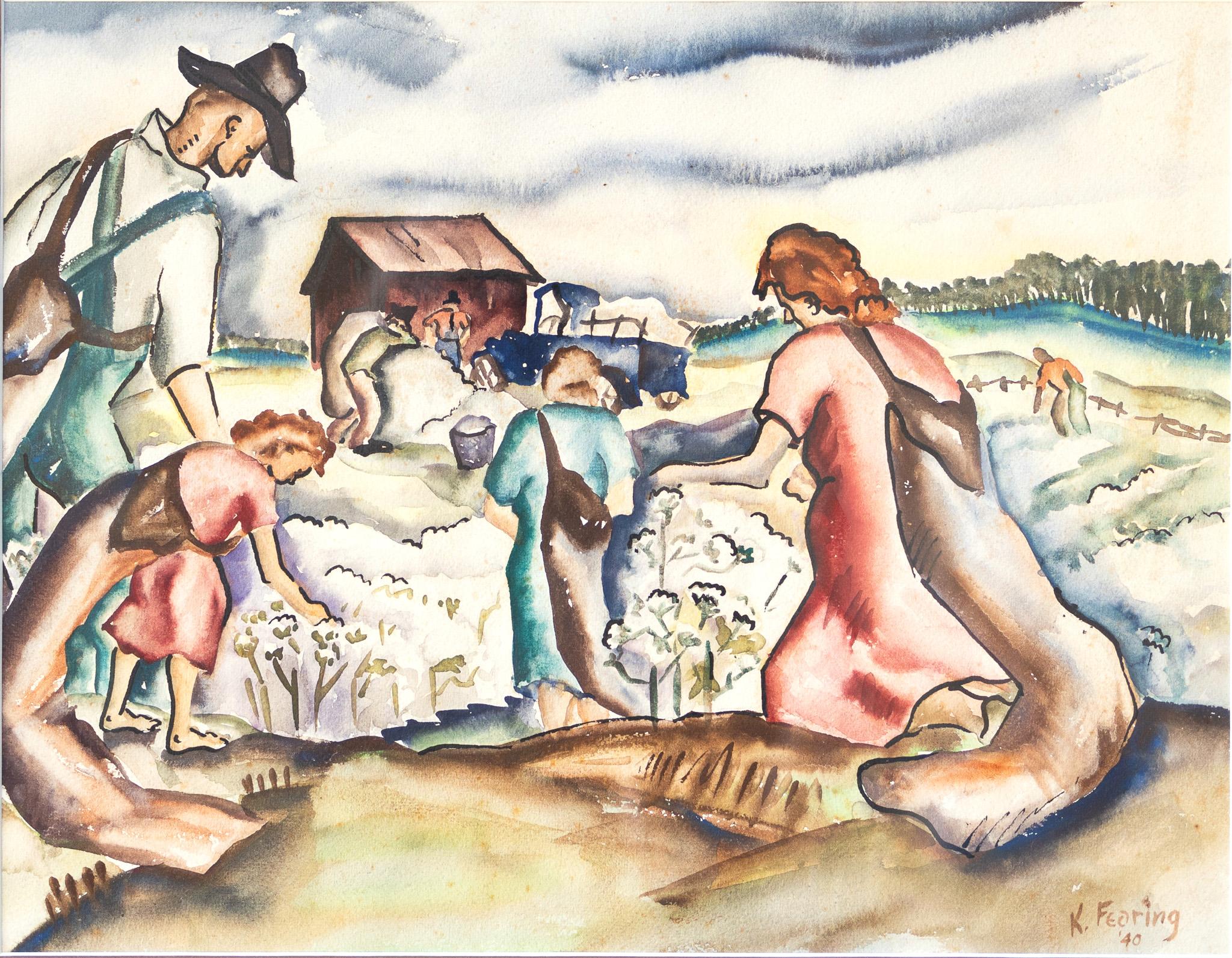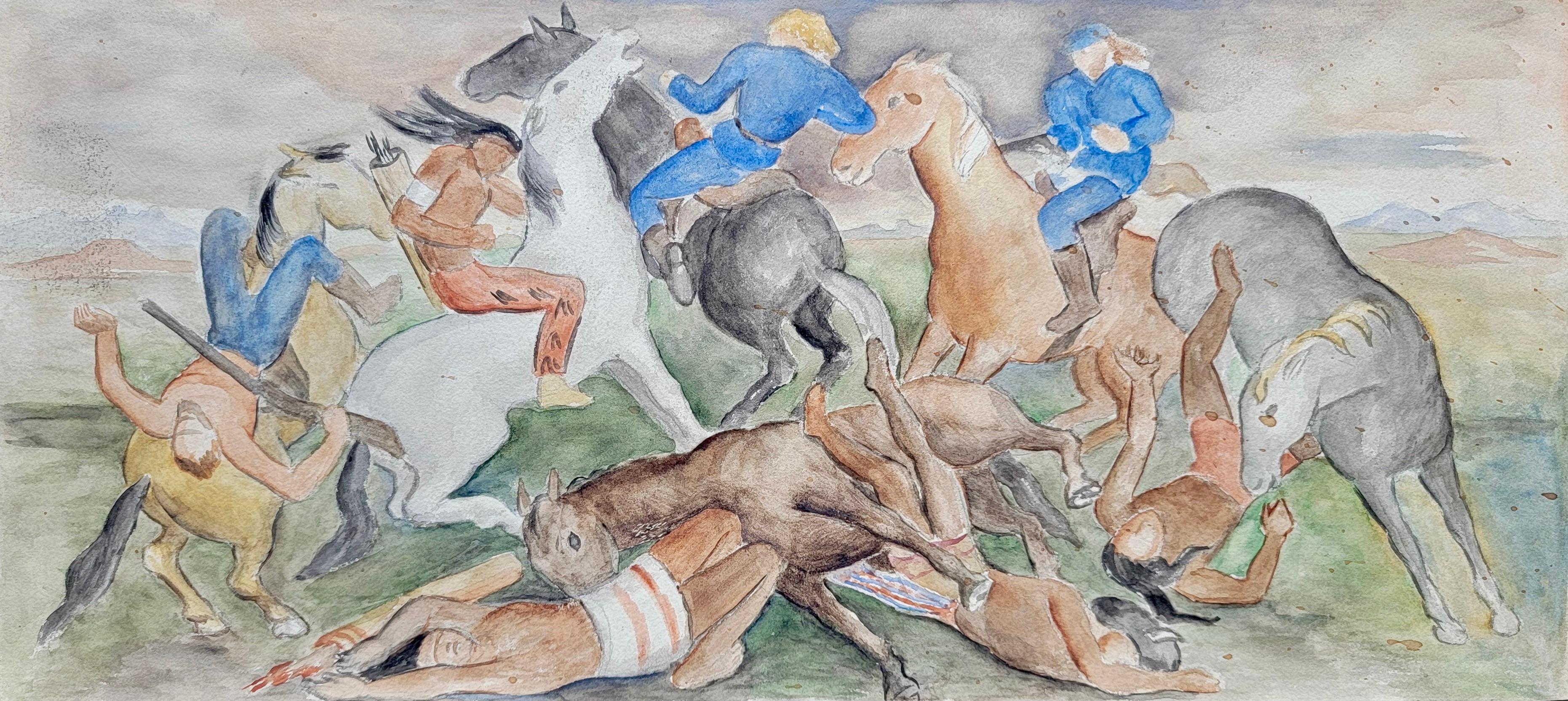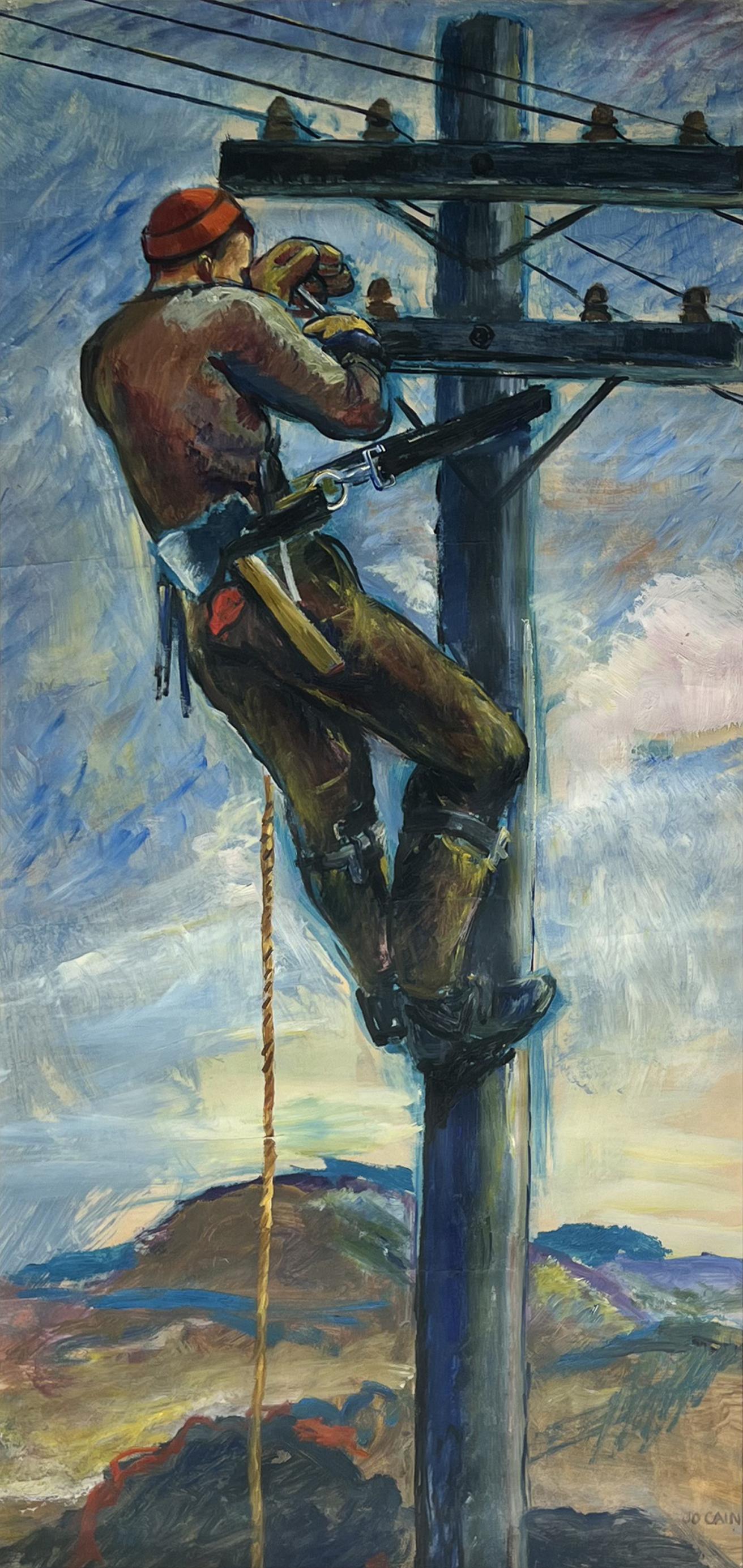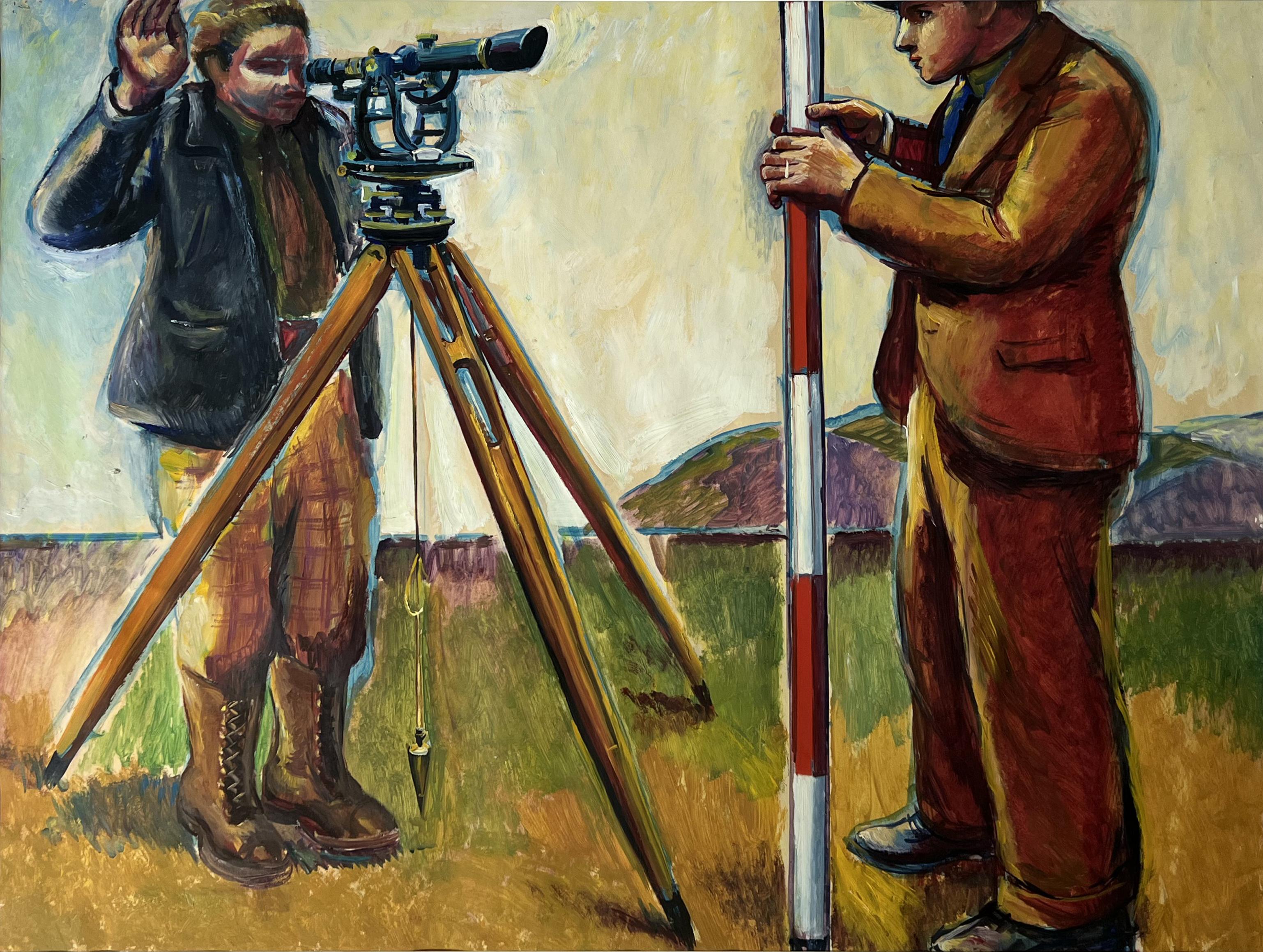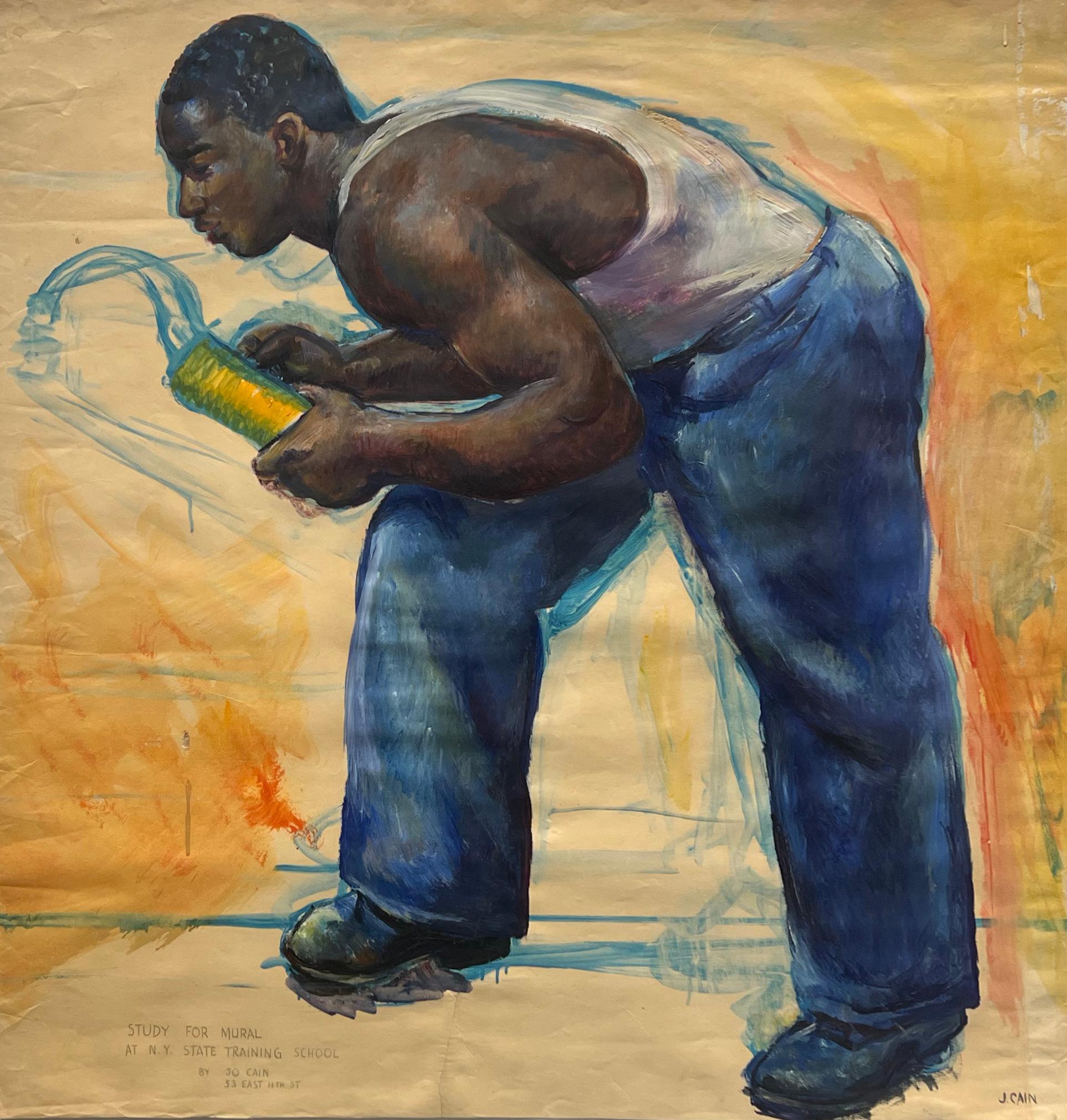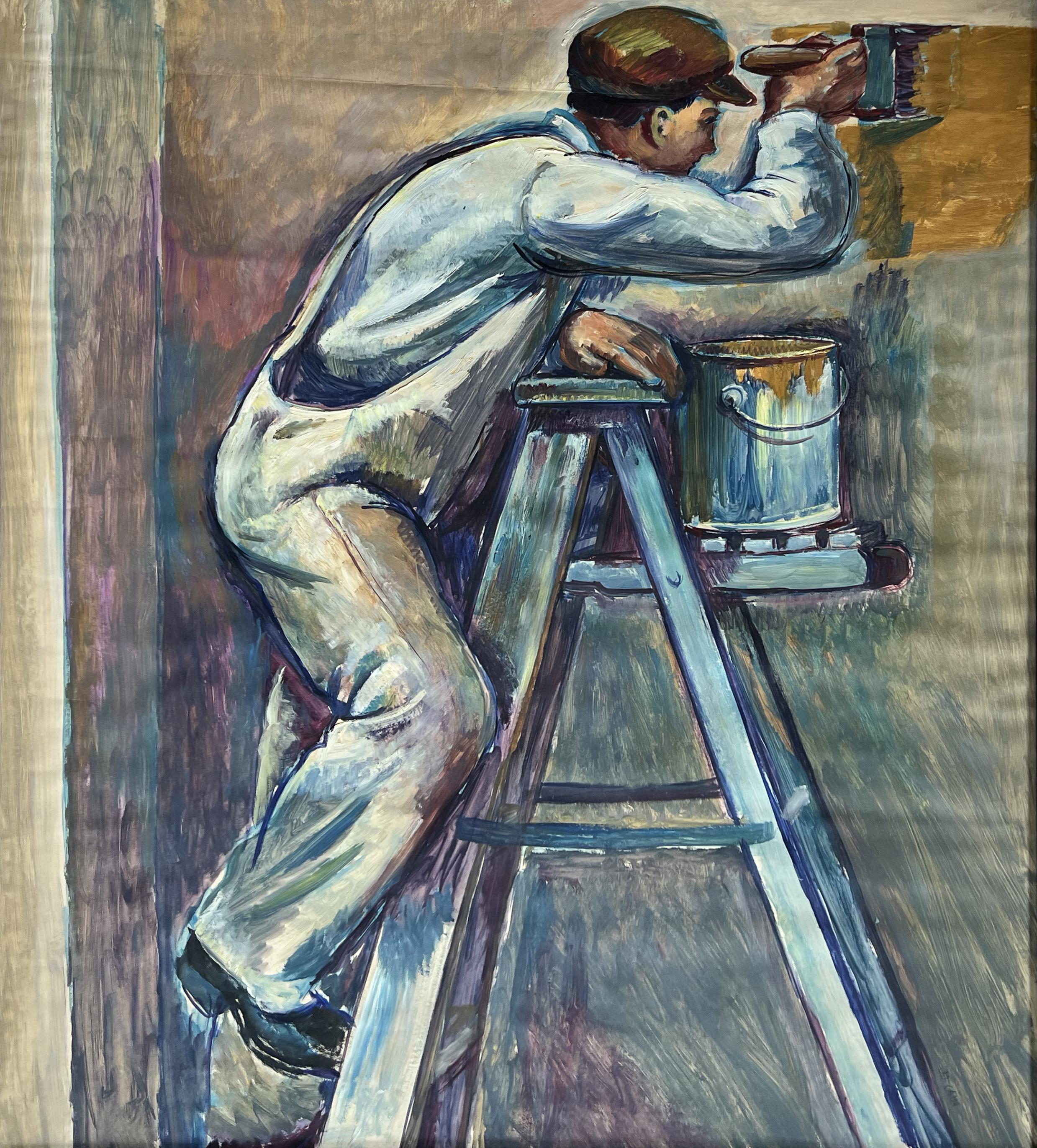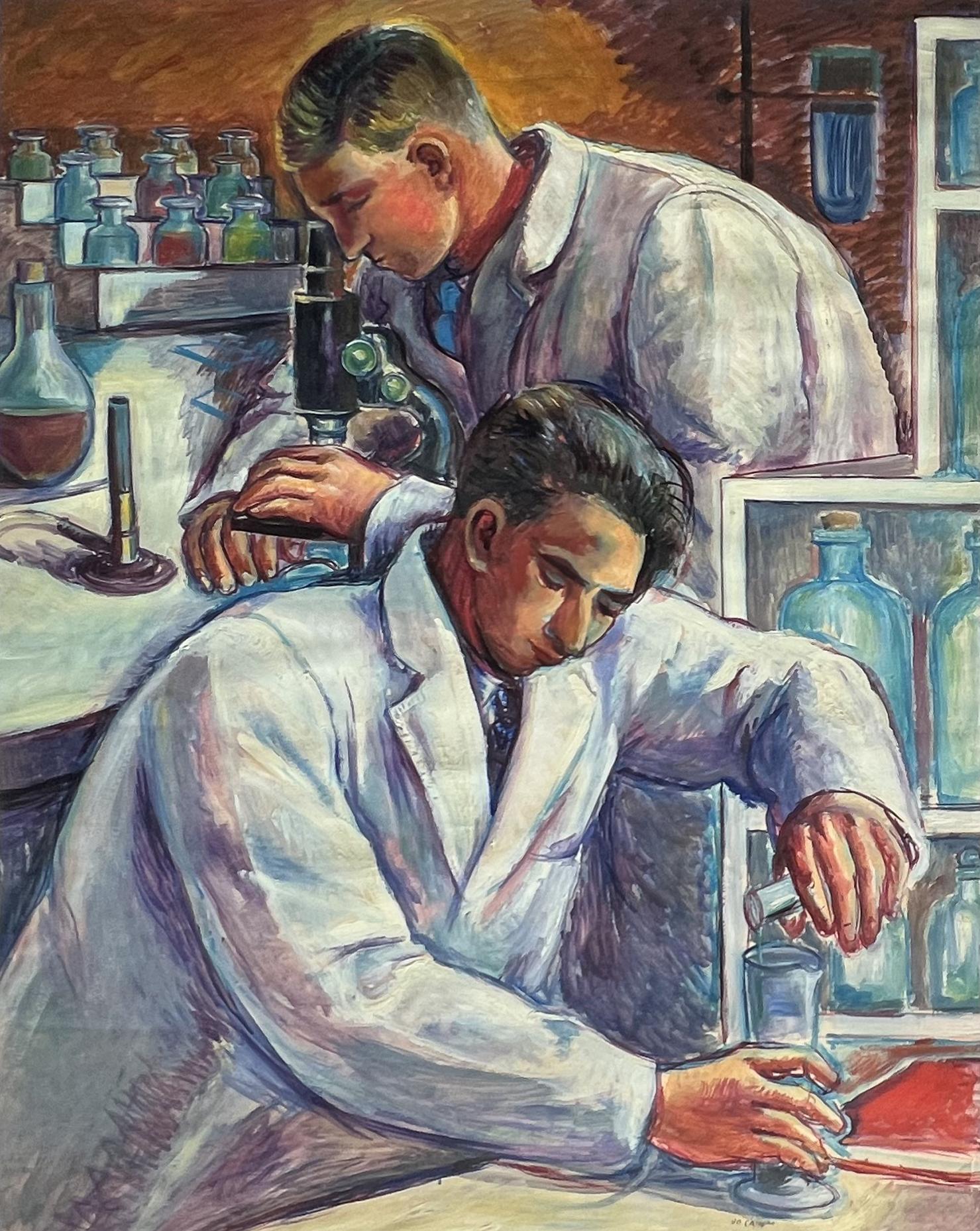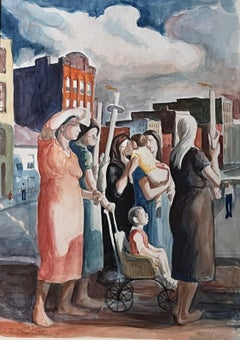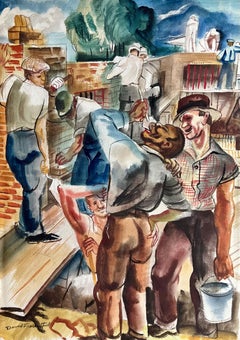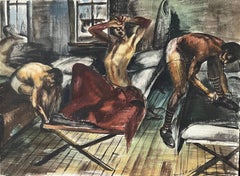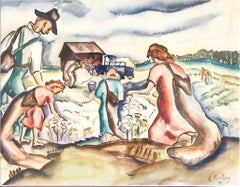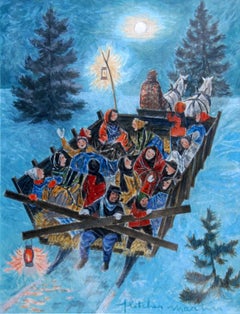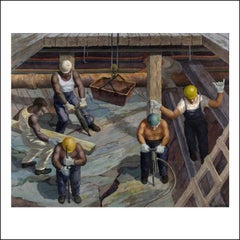
"For New Subway, " NYC, WPA, Men Working Modern Art Mid Century American Scene
View Similar Items
Want more images or videos?
Request additional images or videos from the seller
1 of 5
George Beline"For New Subway, " NYC, WPA, Men Working Modern Art Mid Century American Scene1940s
1940s
About the Item
- Creator:George Beline (1887 - 1971)
- Creation Year:1940s
- Dimensions:Height: 29 in (73.66 cm)Width: 34 in (86.36 cm)
- Medium:
- Movement & Style:
- Period:
- Condition:
- Gallery Location:New York, NY
- Reference Number:1stDibs: LU115624180971
About the Seller
5.0
Platinum Seller
These expertly vetted sellers are 1stDibs' most experienced sellers and are rated highest by our customers.
Established in 2008
1stDibs seller since 2019
165 sales on 1stDibs
More From This SellerView All
- "Going to the Festival" WPA Ashcan 20th Century American Scene Modern RealismBy Daniel Ralph CelentanoLocated in New York, NY"Going to the Festival" WPA Ashcan 20th Century American Scene Modern Realism Daniel Celentano (1902 - 1980) "Going to the Festival," 14 1/2 x 10 1/2. Watercolor on paper, c. 1930s....Category
1930s American Realist Figurative Drawings and Watercolors
MaterialsPaper, Watercolor
- "Brick Layers" WPA American Scene Mid 20th Century Modern Drawing Men WorkingBy David FredenthalLocated in New York, NY"Brick Layers" WPA American Scene Mid 20th Century Modern Drawing Men Working. 21 x 15 inches Watercolor on paper. c. 1938. Signed lower left. BIO David Fredenthal (1914 - 1958) was one ot America's most respected watercolor artists. He was famous for his bold, intensely vigorous and complex paintings and drawings that expressed his deep feeling for excitement with life and living. He was a draftsman with seemingly a special gift for catching anything, physically and emotionally on the spot, and he never went anywhere without three or four loaded pens and a sketchbook in his pocket. As part of the WPA project he executed a number of murals including the Sports Pavilion on the Heinz Building of the New York World's Fair 1939. Some of his fresco and mural techniques were inspired by his friendship with Diego Rivera who had admired and encouraged him in the early 1930's. After he won a traveling scholarship to Europe from The Museum of Modern Art at age 19, he was the recipient of two Guggenheim grants in Painting. He had his first solo exhibition at the Downtown Gallery in New York in 1937 at age 23, and many others after that including the Whitney Museum of American Art in 1947. Because of Fredenthal's prodigious drawing gifts, he was chosen by Erskine Caldwell to illustrate his novel "Tobacco Road" in 1940. He was a War Artist Correspondent for both the State Department (the European and Asian fronts) and Life magazine from 1943 to 1946 and his work was featured in Life magazine regularly during the war and after until the end of his life. Also featured in Life in 1956 were drawings that Fredenthal had vividly recorded on his sketch pad, of the entire filming of the movie, The Pride and the Passion, starring Cary Grant, Sophia Loren, and Frank Sinatra, along the treacherous mountain passes of Spain. Though he was fiercely committed to an art that expressed deeply human social values and issues and was quite hostile to abstraction, he was friendly with a number of abstract artists such as David Smith, Ad Reinhardt, Philip Guston, Paul Feeley, and Herman Cherry.Category
1930s American Realist Figurative Drawings and Watercolors
MaterialsWatercolor, Handmade Paper
- "Men in Barracks" WPA Mid 20th Century American Scene Realism Gay Modernism WWIIBy David FredenthalLocated in New York, NY"Men in Barracks" WPA Mid 20th Century American Scene Realism Gay Modernism WWII. 18 x 24 inches Watercolor on paper. c. 1940s. Signed lower right. BIO ...Category
1940s American Realist Figurative Drawings and Watercolors
MaterialsWatercolor, Paper
- NYC Subway Mid 20th Century American Scene Social Realism WPA Modern 1930sBy Daniel Ralph CelentanoLocated in New York, NYNYC Subway Riders Mid 20th Century American Scene Social Realism WPA Modern 1930s Daniel Celentano (1902 - 1980) Subway Scene, 1930s 8 x 9 inches Ink and wash on paper Singed lower ...Category
1930s American Realist Figurative Drawings and Watercolors
MaterialsPaper, Ink, Gouache
- Industrial Man Working Mid 20th Century American Scene Social Realism Modern WPABy Jo CainLocated in New York, NYIndustrial Man Working Mid 20th Century American Scene Social Realism Modern WPA Jo Cain (1904 - 2003) Hammering Nails 39 x 50 ½ inches Gouache on paper c. 19...Category
1930s American Realist Figurative Drawings and Watercolors
MaterialsPaper, Gouache
- WPA Post Office Mural Study Native American Scene Regionalism Social RealismBy Louise RonnebeckLocated in New York, NYWPA Post Office Mural Study Native American Scene Regionalism Social Realism Louise Emerson Ronnebeck (1901 - 1980) Proposal Sketch for Worland Wyoming Post Office WPA Mural Project Image: 7 x 15 inches Board 14 x 22 inches Watercolor on paper, attached to black/gray cardboard/thick paper c. 1937 Signed lower right Written in Louise's hand on mounting paper in white chalk/pencil: "Sketch for Mural...Category
1930s American Realist Figurative Drawings and Watercolors
MaterialsPaper, Cardboard, Watercolor
You May Also Like
- "Sharecroppers" Watercolor Scene of Laborers Working in a Cotton FieldBy Kelly FearingLocated in Austin, TXThis watercolor painting from 1940 depicts a scene of sharecroppers working in a cotton field. This piece represents a blend of American Realism and a more figurative, impressionisti...Category
1940s American Realist Figurative Drawings and Watercolors
MaterialsWatercolor, Archival Paper
- "Lobstermen in Gloucester, Mass." Lionel Reiss WPA Social Realism FishermenBy Lionel S. ReissLocated in New York, NYLionel S. Reiss (1894 - 1988) Lobstermen in Gloucester, Massachusetts, circa 1943 Watercolor on paper Sight 17 1/2 x 23 inches Signed lower left Provenance: Private Collection, Las Vegas, Nevada In describing his own style, Lionel Reiss wrote, “By nature, inclination, and training, I have long since recognized the fact that...I belong to the category of those who can only gladly affirm the reality of the world I live in.” Reiss’s subject matter was wide-ranging, including gritty New York scenes, landscapes of bucolic Bucks County, Pennsylvania, and seascapes around Gloucester, Massachusetts. However, it was as a painter of Jewish life—both in Israel and in Europe before World War II—that Reiss excelled. I.B. Singer, the Nobel Prize winner for Literature, noted that Reiss was “essentially an artist of the nineteenth century, and because of this he had the power and the courage to tell visually the story of a people.” Although Reiss was born in Jaroslaw, Poland, his family immigrated to the United States in 1898 when he was four years old. Reiss's family settled on New York City’s Lower East Side and he lived in the city for most of his life. Reiss attended the Art Students League and then worked as a commercial artist for newspapers and publishers. As art director for Metro-Goldwyn-Mayer, he supposedly created the studio’s famous lion logo. After World War I, Reiss became fascinated with Jewish life in the ‘Old World.’ In 1921 he left his advertising work and spent the next ten years traveling in Europe, the Middle East, and North Africa. Like noted Jewish photographers Alter Kacyzne and Roman Vishniac, Reiss depicted Jewish life in Poland prior to World War II. He later wrote, “My trip encompassed three main objectives: to make ethnic studies of Jewish types wherever I traveled; to paint and draw Jewish life, as I saw it and felt it, in all aspects; and to round out my work in Israel.” In Europe, Reiss recorded quotidian scenes in a variety of media and different settings such as Paris, Amsterdam, the Venice ghetto, the Jewish cemetery in Prague, and an array of shops, synagogues, streets, and marketplaces in the Jewish quarters of Warsaw, Lodz, Krakow, Lublin, Vilna, Ternopil, and Kovno. He paid great attention to details of dress, hair, and facial features, and his work became noted for its descriptive quality. A selection of Reiss’s portraits appeared in 1938 in his book My Models Were Jews. In this book, published on the eve of the Holocaust, Reiss argued that there was “no such thing as a ‘Jewish race’.” Instead, he claimed that the Jewish people were a cultural group with a great deal of diversity within and between Jewish communities around the world. Franz Boas...Category
1940s American Realist Landscape Paintings
MaterialsPaper, Watercolor
- "Sleigh Ride, Winter, " Fletcher Martin, Woodstock, Holiday Scene IllustrationBy Fletcher MartinLocated in New York, NYFletcher Martin (1904 - 1979) Sleigh Ride, Woodstock, New York circa 1955 Watercolor on paper 14 x 11 inches Signed lower right Provenance: James Cox Galler...Category
1950s American Realist Landscape Drawings and Watercolors
MaterialsPaper, Watercolor
- Schooners along the Hudson, West Point Academy in the distance.Located in Middletown, NYA serene Hudson River scene by a student of Louis Comfort Tiffany. Anna May Walling was born in 1881, a native of Goshen, New York. She was a graduate of the Blair Academy, and Prat...Category
Early 20th Century American Realist Landscape Drawings and Watercolors
MaterialsWatercolor, Handmade Paper
- David Dewey Watercolor of Reader's Digest HeadquartersBy David DeweyLocated in Larchmont, NYDavid Dewey (B. 1946) Reader's Digest Headquarters, 1996 Watercolor on paper Sight: 24 x 18 1/2 in. Framed: 36 x 29 3/4 x 1 in. Living on the Maine coast, David Dewey is a watercolo...Category
1990s American Realist Landscape Drawings and Watercolors
MaterialsPaper, Watercolor
- Tourists Viewing the Temple of Karnak, EgyptBy Eleanor Parke CustisLocated in New York, NYEleanor Park Custis painted scenes as varied as the artist's travels: from her hometown of Washington, D.C., to the coastal towns of New England; from the prosperous fishing villages of Brittany, to Venice and the mountain villages and lakes of northern Italy. While Custis's subjects are diverse, her style is consistent and distinctive throughout this body of work. Her use of flat areas of color delineated by dark contours is reminiscent of the aesthetics of woodblock printing. Like many artists of the day, she was profoundly influenced by Japanese woodblock prints, and her adaptation of the aesthetic by 1924 led to her most productive artistic period. Eleanor Custis hailed from a socially prominent Washington, D.C., family. She was distantly related to Martha Custis Washington, America's first First Lady. Custis began three years of formal art training in the autumn of 1915 at the Corcoran School of Art in Washington, and was guided and inspired by Impressionist artist Edmund C. Tarbell, one of the Ten American Painters, who became the Corcoran School's principal in 1918. Custis exhibited widely in many of the Washington art societies and clubs for much of her career. She was also a frequent exhibitor at the Grand Central Art Galleries in New York City; her last one-woman show there was in April 1945. Custis's mature style emerged in scenes of the streets, wharves, and drydocks of seacoast villages from Maine to Massachusetts, which she visited during the summers of 1924 and 1925. She was working in Gloucester, Massachusetts in August 1924, and painted several gouaches of the town's wharves and winding streets, including In Gloucester Harbor and At the Drydock, Gloucester. During her stay, Custis may have met Jane Peterson or at least must have seen her work, the best of which was executed in Gloucester during the preceding ten years. The similarity between their styles is unmistakable, but, while it may be tempting to suggest that Custis was influenced by Peterson during her summer in Gloucester, the connection between their work is probably more a case of shared aesthetics and common European influences. Custis expanded her subject repertoire with three trips to Europe between 1926 and 1929, and was inspired by the Old World charm of Holland, northern France, Switzerland, and Italy, leading to such works as New Kirk, Delft, Holland, Market Day in Quimper, At the Foot of the Matterhorn, and The Town Square, Varenna. A Mediterranean cruise in 1934 introduced her to the Near East, and the bustling, colorful streets and bazaars of Cairo, captured in works like A Street in Cairo, Egypt and A Moroccan Jug...Category
20th Century American Realist Landscape Drawings and Watercolors
MaterialsPaper, Gouache
Recently Viewed
View AllMore Ways To Browse
Nyc Wpa Paintings
George Wachsteter
Fauve Watercolor
Vintage Aesthetic Pastel
Nude Stained Glass
Matisse Verve
Horse Pencil Drawings
Charcoal City Scenes
Red Chalk On Paper
Erte Painting
Ivory Pen
Quebec Watercolour
Orientalist Watercolor
Quebec Watercolor
Orientalist Watercolour
Antique Weekly Paper
Antique French Drawings And Watercolors
17th Century Ink Drawings
